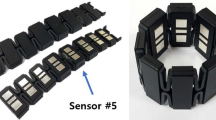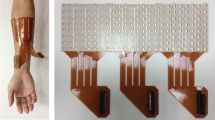Abstract
Historically, the investigations of electromyography (EMG) pattern recognition-based classification of intentional movements for control of multifunctional prostheses have adopted the filter cut-off frequency and sampling rate that are commonly used in EMG research fields. In practical implementation of a multifunctional prosthesis control, it is desired to have a higher high-pass cut-off frequency to reduce more motion artifacts and to use a lower sampling rate to save the data processing time and memory of the prosthesis controller. However, it remains unclear whether a high high-pass cut-off frequency and a low-sampling rate still preserve sufficient neural control information for accurate classification of movements. In this study, we investigated the effects of high-pass cut-off frequency and sampling rate on accuracy in identifying 11 classes of arm and hand movements in both able-bodied subjects and arm amputees. Compared to a 5-Hz high-pass cut-off frequency, excluding the EMG components below 60 Hz decreased the average accuracy of 0.1% in classifying the 11 movements across able-bodied subjects and increased the average accuracy of 0.1 and 0.4% among the transradial (TR) and shoulder disarticulation (SD) amputees, respectively. Using a 500 Hz instead of a 1-kHz sampling rate, the average classification accuracy only dropped about 2.0% in arm amputees. The combination of sampling rate and high-pass cut-off frequency of 500 and 60 Hz only resulted in about 2.3% decrease in average accuracy for TR amputees and 0.4% decrease for SD amputees in comparison to the generally used values of 1 kHz and 5 Hz. These results suggest that the combination of sampling rate of 500 Hz and high-pass cut-off frequency of 60 Hz should be an optimal selection in EMG recordings for recognition of different arm movements without sacrificing too much of classification accuracy which can also remove most of motion artifacts and power-line interferences for improving the performance of myoelectric prosthesis control.





Similar content being viewed by others

References
Ajiboye, A. B., and R. B. Weir. A heuristic fuzzy logic approach to EMG pattern recognition for multifunctional prosthesis control. IEEE Trans. Neural Syst. Rehabil. Eng. 13(3):280–291, 2005.
Chan, A. D., and K. B. Englehart. Continuous myoelectric control for powered prostheses using hidden Markov models. IEEE Trans. Biomed. Eng. 52:121–124, 2005.
Chu, J. U., I. Moon, and M. S. Mun. A real-time EMG pattern recognition system based on linear-nonlinear feature projection for a multifunction myoelectric hand. IEEE Trans. Biomed. Eng. 53:2232–2239, 2006.
Clancy, E. A., S. Bouchard, and D. Rancourt. Estimation and application of EMG amplitude during dynamic contractions. IEEE Eng. Med. Biol. Mag. 20(6):47–54, 2001.
Clancy, E. A., E. L. Morin, and R. Merletti. Sampling, noise-reduction and amplitude estimation issues in surface electromyography. J. Electromyogr. Kinesiol. 12:1–16, 2002.
Englehart, K., and B. Hudgins. A robust, real-time control scheme for multifunction myoelectric control. IEEE Trans. Biomed. Eng. 50(7):848–854, 2003.
Englehart, K., B. Hudgins, and A. D. Chan. Continuous multifunction myoelectric control using pattern recognition. Tech. Disabil. 15(2):95–103, 2003.
Farina, D., R. Merletti, and R. M. Enoka. The extraction of neural strategies from the surface EMG. J. Appl. Physiol. 96:1486–1495, 2004.
Gallant, P. J., E. L. Morin, and L. E. Peppard. Feature-based classification of myoelectric signals using artificial neural networks. Med. Biol. Eng. Comput. 36:4485–4489, 1998.
Hargrove, L., K. Englehart, and B. Hudgins. A comparison of surface and intramuscular myoelectric signal classification. IEEE Trans. Biomed. Eng. 54:847–853, 2007.
Huang, Y. G., K. B. Englehart, B. Hudgins, and A. D. Chan. A Gaussian mixture model based classification scheme for myoelectric control of powered upper limb prostheses. IEEE Trans. Biomed. Eng. 52(11):1801–1811, 2005.
Huang, H., P. Zhou, G. Li, and T. A. Kuiken. An analysis of EMG electrode configuration for targeted muscle reinnervation based neural machine interface. IEEE Trans. Neural Syst. Rehabil. Eng. 16(1):37–45, 2008.
Huang, H., P. Zhou, G. Li, and T. A. Kuiken. Spatial filtering improves EMG classification accuracy following targeted muscle reinnervation. Ann. Biomed. Eng. 37:1849–1857, 2009.
Hudgins, B. S., P. A. Parker, and R. N. Scott. A new strategy for multi-functional myoelectric control. IEEE Trans. Biomed. Eng. 40(1):82–94, 1993.
Ives, J. C., and J. K. Wigglesworth. Sampling rate effects on surface EMG timing and amplitude measures. Clin. Biomech. 18:543–552, 2003.
Kuiken, T. A. Consideration of nerve-muscle grafts to improve the control of artificial arms. J. Technol. Disabil. 15(2):105–111, 2003.
Kuiken, T. A. Targeted reinnervation for improved prosthetic function. Phys. Med. Rehabil. Clin. N. Am. 17(1):1–13, 2006.
Kuiken, T. A., G. A. Dumanian, R. D. Lipschutz, L. A. Miller, and K. A. Stubblefield. The use of targeted muscle reinnervation for improved myoelectric prosthesis control in a bilateral shoulder disarticulation amputee. Prosthet. Orthot. Int. 28(3):245–253, 2004.
Kuiken, T. A., G. Li, B. A. Lock, R. D. Lipschutz, L. A. Miller, K. A. Stubblefield, and K. B. Englehart. Targeted muscle reinnervation for real-time myoelectric control of multifunction artificial arms. JAMA 301:619–628, 2009.
Li, G., A. E. Schultz, and T. A. Kuiken. Quantifying pattern recognition based myoelectric control of multifunctional transradial prostheses. IEEE Trans. Neural Syst. Rehabil. Eng. 18:185–192, 2010.
Lock, B. A., K. Englehart, and B. Hudgins. Real-time myoelectric control in a virtual environment to relate usability vs. accuracy. In: MyoElectric Controls Symposium, New Brunswick, Fredericton, pp. 122–127, 2005.
Parker, P. A., and R. N. Scott. Myoelectric control of prostheses. Crit. Rev. Biomed. Eng. 13(4):283–310, 1986.
Reaz, M. B. I., M. S. Hussain, and F. Mohd-Yasin. Techniques of EMG signal analysis: detection, processing, classification and applications. Biol. Proced. Online 8:11–35, 2006.
Sears, H. H. Trends in upper-extremity prosthetic development. In: Atlas of Limb Prosthetics, edited by J. H. Bowker, and J. W. Michael. St. Louis: Mosby, 1992.
Stegeman, D. F. and H. J. Hermens. Standards for surface electromyography: the European project “Surface EMG for non-invasive assessment of muscles (SENIAM),” http://www.med.uni-jena.de/motorik/pdf/stegeman.pdf, 2007.
Winter, D. A. Biomechanics and Motor Control of Human Movement. New York: Wiley Interscience, 1990.
Zhou, P., M. M. Lowery, K. B. Englehart, H. Huang, G. Li, L. Hargrove, J. P. A. Dewald, and T. A. Kuiken. Decoding a new neural machine interface for control of artificial limbs. J. Neurophysiol. 98(5):2974–2982, 2007.
Acknowledgments
The authors would like to thank Dr. Todd Kuiken at Neural Engineering Center for Artificial Limbs, Rehabilitation Institute of Chicago, USA, for supplying the raw EMG data from SD amputees for this study. This work was supported in part by the National Natural Science Foundation of China under Grant #60971076, Hong Kong Innovation and Technology Fund (ITF) #GHP/031/08, the Shenzhen Governmental Basic Research Grand #JC200903160393A, and grants from Guangdong Key Laboratory of Robotics and Intelligent System, Guangdong Province #2009A060800016 and Shenzhen Key Laboratory of Neuropsychiatric Modulation. We also thank the industrial sponsors Standard Telecommunication Ltd., Jetfly Technology Ltd., Golden Meditech Company Ltd., Bird International Ltd., Bright Steps Corporation and PCCW for their supports to the ITF project.
Author information
Authors and Affiliations
Corresponding author
Additional information
Associate Editor Thurmon E. Lockhart oversaw the review of this article.
Rights and permissions
About this article
Cite this article
Li, G., Li, Y., Yu, L. et al. Conditioning and Sampling Issues of EMG Signals in Motion Recognition of Multifunctional Myoelectric Prostheses. Ann Biomed Eng 39, 1779–1787 (2011). https://doi.org/10.1007/s10439-011-0265-x
Received:
Accepted:
Published:
Issue Date:
DOI: https://doi.org/10.1007/s10439-011-0265-x



